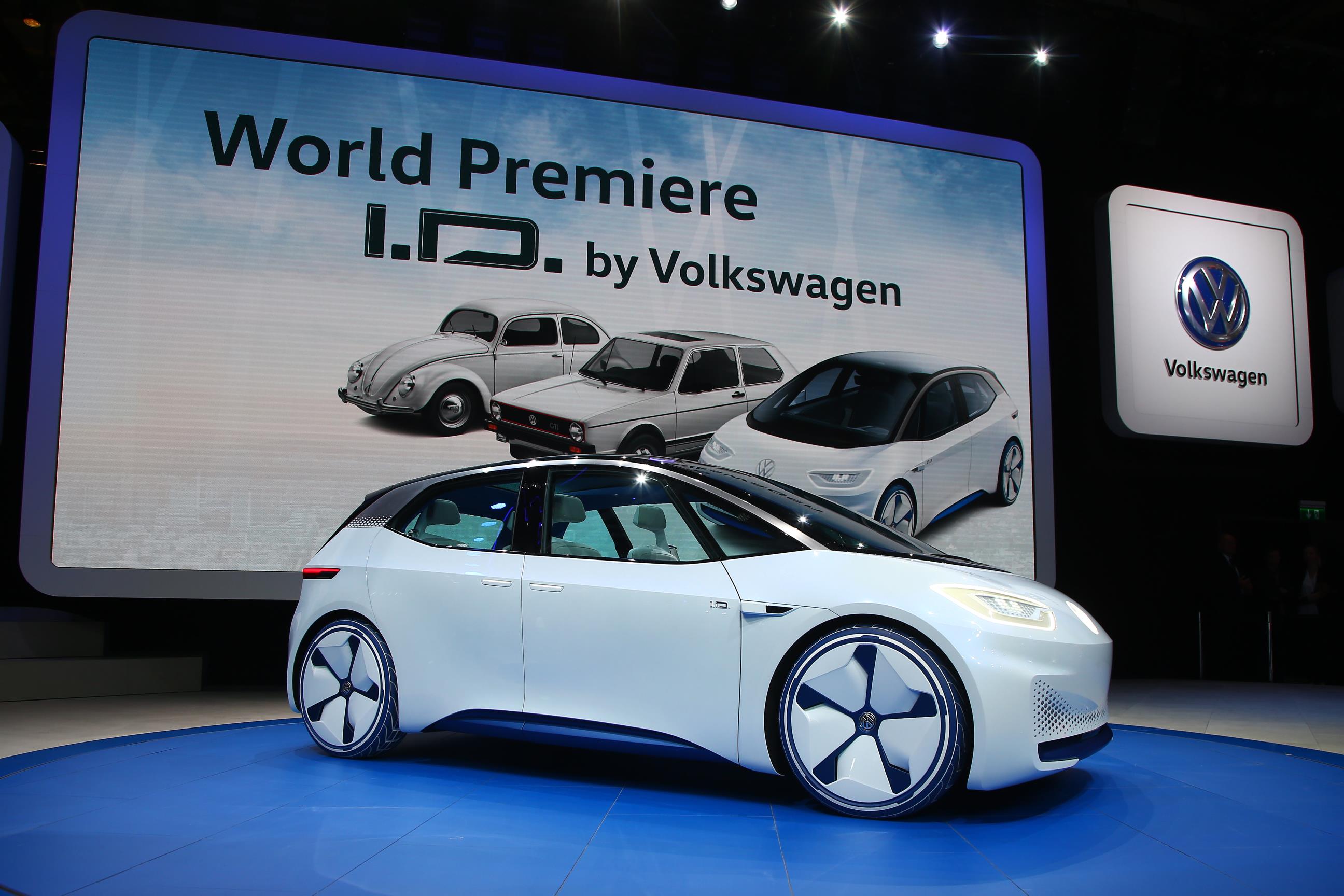
World premiere of the I.D. starts the countdown to a new era for Volkswagen
Volkswagen plans for the visionary I.D. to hit the road in 2020
An ambassador: the I.D. is the first Volkswagen of a new fleet of electric cars
It runs and runs: the I.D. has a range of 400 to 600 kilometres
Ready for the future: the I.D. concept car demonstrates a fully automated mode for the year 2025
Key facts – the I.D. in keywords
1. I.D. is the first Volkswagen in a completely new fleet of highly innovative electric vehicles.
2. I.D. is immediately recognisable as a zero-emission vehicle thanks to a newly developed design DNA for electric cars.
3. I.D. is driven by an electric motor with an output of 125 kW and has a range of between 400 and 600 kilometres on a single battery charge.
4. I.D. has an interior that offers an entirely new spatial experience with the Open Space.
5. I.D. will be launched as a compact electric car in 2020 parallel to the Golf.
6. As a concept car, I.D. gives us a first tangible glimpse of fully automated driving – this mode will be offered from 2025 onwards.
7. I.D. retracts its multifunction steering wheel into the dashpad when in fully automated mode (“I.D. Pilot”).
8. I.D. can receive parcels using a new delivery service, if its owner isn’t at home.
9. I.D. is the first compact Volkswagen based on the Modular Electric Drive Kit (MEB).
10. Volkswagen has set itself the goal of selling a million electric cars a year by 2025.
Think New. – Volkswagen sets a course for the future
Wolfsburg / Paris, September 2016. Volkswagen is embarking on its journey to the future at the Paris Motor Show with the world premiere of the visionary I.D.: I.D. is a highly automated electric car that will cover a distance of 400 to 600 kilometres on a single battery charge. The production version of the I.D. is due to be launched in 2020 at a price on a par with comparably powerful and well-equipped Golf, but Volkswagen is looking even further ahead with this concept car: in “I.D. Pilot” mode, the electric car is capable of fully automated driving – this technology should be ready for series production in 2025. Volkswagen has also set itself the goal of selling a million electric cars a year by 2025; the production version of the I.D. will make a decisive contribution towards this in the ramp-up of e-mobility.
The fact is that the I.D. combines the digitally connected world with electric drive, if required, and heralds a new era of fully automated driving. Analogously, this resulted in a visionary design for the electric cars of the future. It puts the spotlight on the individual: it is positive, honest, and fascinating to look at. Volkswagen has made electric and fully automated driving – the factors that will change everything about mobility – conspicuous with its innovative design language, in the interior, too, where the ambience of the conventional driving environment has been transformed into the interactive centre of a mobile lounge – a supremely versatile Open Space. The spaciousness of this area and the intuitive, clear functionality allow you to experience mobility in a completely new way.
The present and the future merge into one. The I.D. represents the world of “the day after tomorrow”. But the latest generation of the e-Golf, with a zero-emission range of up to 300 kilometres and new gesture control, will be on the road “tomorrow”. The world of “today” is also embodied in state-of-the-art Volkswagens like the new Tiguan, which has launched the digitisation of the car interior with its Active Info Display and head-up display. We thus see three eras represented at once with the Tiguan, the e-Golf and the I.D. concept car, which together point the way from the present to the future – here at the Volkswagen booth.
2020 and 2025 in a single car. The I.D. is the first vehicle to showcase Volkswagen’s iconic new design language for compact electric vehicles. The clear, iconic exterior and interior design – which puts the spotlight on the individual in every respect as well as the zero-emission drive – together preview the year 2020. For absolute clarity: I.D. is, today, a concept car; but I.D. is coming. We can expect to see the I.D. on our roads within the next four years, and its fully automated driving capability gives us a glimpse of the year 2025. And so the I.D. is an automotive protagonist of the progressive, forward-looking Volkswagen brand strategy “Think New.” This strategy is based on four central areas of innovation, which are also reflected in the new Volkswagen design approach for electric vehicles and, thus, in the I.D.:
- Smart Sustainability – Volkswagen is advancing the development of innovative high-volume electric cars;
- Automated Driving – Volkswagen is going to make cars even safer and more comfortable thanks to automated driving;
- Intuitive Usability – Volkswagen has put its focus on vehicles that are intuitive to operate and feature new display and control concepts;
- Connected Community – Volkswagen will interconnect humans, cars and the environment with a Volkswagen user identity, in future.
I.D. – electric vehicle with the potential to become a best-seller
A vehicle concept for a new era. I.D. is Volkswagen’s first compact concept car based on the new MEB vehicle architecture. MEB stands for “Modularer Elektrifizierungsbaukasten” (“Modular Electric Drive Kit”) – and it was conceived for pure electric drive. The ground-breaking MEB thus corresponds with the key mobility requirements of the future. This is why the newly defined vehicle architecture of the I.D. is considered to be a milestone in the car development by Volkswagen AG, while at the same time provide the basis for the development of many more all-electric cars. The concept behind the I.D. guarantees the best possible ride comfort, optimum use of space, maximum safety and ground-breaking sustainability, thus redefining the parameters of “drive”, “space” and “comfort”. This is underlined by:
- the long wheelbase with very short overhangs;
- a front end structure that, in addition to the highest level of safety, enables a high front wheel steering angle and thus a sensationally tight turning circle of just 9.9 m;
- the flat lithium-ion battery integrated in the floor, lowering the vehicle’s centre of gravity and thus resulting in an ideal axle load/weight distribution;
- a multi-link rear axle with an integrated drive unit and decoupled subframe; this axle layout makes for optimum driving dynamics and ideal acoustics.
I.D. has the potential to make history. For Volkswagen, the world premiere of the iconic I.D. in Paris – with its iconic, fresh design – marks a watershed. This car is as revolutionary as the Beetle was seven decades ago and the first Golf was 40 years ago – which went on to become two of the world’s most successful cars of all time. The I.D. has the potential to make history, too. It has been designed to be a compact all-rounder that will help to make electric cars the ‘everyday’ choice, with its impressive electric range and an attractive price. A car in which the driver can activate the fully automated mode “I.D. Pilot” just by touching the Volkswagen logo on the steering wheel. With this, the electrically adjustable and retractable steering wheel disappears into the dashpad to form a single entity flush with the dashboard, boosting the lounge feeling in fully automated mode of the Open Space concept – the all new interior layout of the I.D., because the architecture of the drivetrain with an electric motor on the rear axle, and a high-voltage battery in the floor of the vehicle, liberates more space, more light, greater flexibility and more freedom than was ever possible in a car with a length of slightly over 4 metres. The I.D. is positioned as a compact electric car with which Volkswagen aims to expand its range of high-volume models in parallel to existing global best sellers such as the Polo, Golf, Tiguan and Passat.
Connected Community – the new Volkswagen ID
I.D. knows who’ll be at the wheel today. The idea is that anyone who drives a Volkswagen in the future will be given their own Volkswagen ID. The ID is an individual profile, in which the personal seat and air conditioning settings, the favourite radio stations and songs, the sound system settings, the exterior sounds, the configuration of the navigation system, and the type of ambient lighting, as well as the contact details of the driver’s friends and business associates, are saved. This profile can be securely accessed via the cloud, enabling the I.D. to recognise the legitimate user by their smartphone – the Digital Key – and know who is about to get behind the wheel.
Home-Net. With the I.D. you’ll be at home on the road because, with Volkswagen Home-Net, it will be possible to interconnect your car and home. For example: using cameras in the house you will be able to check whether everything is OK at home from the car. What if your wife, husband, child, girlfriend or boyfriend has forgotten their key? No problem! Just call and look into the camera, and I.D. sends the picture to the Active Info Display, so that the driver can open the front door using an app.
Delivery Service. Pretty soon it could even become perfectly normal to receive parcels on the road, with the new Delivery Service in the boot of your car acting as a mailbox. To put this into perspective: studies show that millions of parcels sent in Europe could alternatively be delivered to the boot of a Volkswagen parked anywhere between Helsinki and Lisbon. If the car owners aren’t at home, I.D. would be able to receive parcels simply and efficiently, or allow them to be collected. The parcel delivery agent is able to locate the car by GPS and is granted temporary permission to open the boot via an app. The car’s owner is then notified via an app or e-mail as soon as the parcel has been delivered and the boot is locked again. Volkswagen is currently working with international logistics service providers to implement this innovative concept.
Iconic Design – e-mobility made visible
Klaus Bischoff, Head of Design, Volkswagen Brand
“Before we first put pen to paper on the drawing board for the I.D. project, we debated the topic of ‘Mobility in the future’ at length. It is clear that the car of the future, and thus the mobile space, will be a place of communication more than ever before. The Open Space in the I.D. is just such a place.”
“The electric powertrain gives our designers far greater freedom. We have shrunk the cooling grilles to a minimum, shifted the axles far outwards and created breathtaking proportions, as demonstrated by the I.D. – an icon of the future.”
“We had the unique opportunity to guide Volkswagen into a new era, and with the I.D we have taken this opportunity.”
I.D. stands for the design of electro-mobility. What is clear from every angle is the I.D. adheres to a new design language for compact Volkswagen electric cars. As is clear from every angle. As already outlined, it puts the spotlight on the individual. Cars like the I.D. aren’t mere machines, but cars that react interactively, and this is reflected in a design that shows a high degree of empathy. Everything is neatly laid out: ample space, maximum precision, a charismatic front end, iconic C-pillars, flowing, sculpted surfaces and expressive wheels are just a few of the design criteria of Volkswagen’s electro-mobility.
The front end – here’s looking at you! An electric car doesn’t need any large cooling grilles, which changes everything when it comes to the design of the front end. Well, almost everything, because Volkswagen also managed to do without cooling grilles on the front of the Beetle and the “Bulli” Volkswagen bus in their original designs. Details like the headlights were of paramount importance. The key significance of these “eyes” remains unchanged to this day, but the static headlights of yesteryear have given way to interactive LED elements on the I.D., to bring the Volkswagen of the future to life. With their completely new design, they dominate the front end: the mobile “eyes”, which are framed by a C-shaped light signature, react to other road users. The large, sculpted bumpers as well as the diffusers in “Anodized Blue” also give the I.D. charisma. The transparent illuminated Volkswagen logo in the front section emphasises the I.D.’s quality and class.
Side profile – farewell to B-pillars and door mirrors. From the side profile it is apparent that the I.D. is characterised by breathtaking proportions and a new stylistic idiom. The design is characterised by high precision, clarity and vision. The voluptuous, flowing surfaces of the side profile below the character line merge elegantly into a single, homogeneous surface.
The new stylistic idiom corresponds with innovative technical solutions: for example, the I.D. has no rigid B-pillars. Instead, the front and rear doors form a protective unit when closed. The rear doors open backwards with a swivel mechanism, opening the way to the Open Space which is very comfortable to climb into. We have also said farewell to the door mirrors. Their job will be done by cameras in the car of the future, which are integrated in the front wings as little high-tech features. The powerful silhouette is perfectly rounded off by white and blue 20-inch alloy wheels with blue low rolling resistance tyres.
Rear section – I.D. won’t forget you! The boot lid, which extends across the full width of the car, is contrasted in black. At the sides, the large rear window is framed by vertical aerodynamic elements and at the base by the strikingly narrow horizontal LED rear lights. The I.D.’s bumper is a prime example of the avant-garde design of Volkswagen’s future electric cars, which looks as if the bumper were made of a stylish piece of aluminium or a translucent block of ice in a single piece. Right at the bottom of the car’s rear section is a blue diffuser. The look is neat and tidy, just like the narrow strip of LED rear lights that wrap around to the flanks and the illuminated Volkswagen logo between them and the transition from the boot lid to the panoramic roof, which is framed in gloss black. You only have to see it once from this angle for the stunning new I.D. to stand out in your memory.
Dimensions – shorter than a Golf, but with a wheelbase almost on a par with the Passat. The four-door I.D. is 4,100 mm long and, thus, 155 mm shorter than a Golf. This concept car is 1,800 mm wide and 1,530 mm high. Between the front and rear sections the I.D. has a remarkable wheelbase of 2,750 mm; which is – despite the shorter exterior length – 130 mm more than the Golf. In fact, the wheelbase is closer to that of the Passat. In contrast, the body overhangs are extremely modest.
Light as a means of communication. Interactive light elements alter the look and feel of the concept car, depending on the mode that the I.D. is in. What is more, the I.D. communicates with its environment using light. The LED light from the headlights interactively mimics the human eye (interactive spotlight), with the headlights reacting to their environment, for instance by looking in the direction of the driver as he approaches the I.D.
- I.D. is parked. If all of the I.D.’s systems are shut down it looks from the front as if its “eyes” are closed. All that can be seen on a parked I.D. is a narrow little strip of LEDs in the headlights.
- I.D. is starting. When the I.D. is “woken up”, it greets its driver and the passengers with an all-new 360° light show: first, the transparent Volkswagen logos (at the front and in the boot lid) light up in white. This is then followed – wrapping around in blue – by the diffuser in the front bumper, the side sills and the rear diffuser. In the final stage of this light show, the I.D. opens its “eyes” and, last but not least, white lines of light shine in the four door handles.
A light signature for each mode. Over and above that, Volkswagen’s designers and engineers have come up with different light scenarios for each operating mode:
- I.D. is charging. While the batteries are charging, the blue light panels on the diffusers and side sills pulsate or “breathe”, while the headlights remain in sleep mode.
- I.D. is being driven. In conventional drive mode the Volkswagen logos and the daytime running lights consisting of LED strips and the LED headlights are on. As the car accelerates, the “eyes” adjust to the higher speed by adopting a more dynamic light signature.
- I.D. is driving itself. To signal that it is in fully automated mode (from 2025), the laser scanners on the roof, which are now extended, as well as the diffusers (at the front and rear) and the side sills are also lit in blue. As the car speeds up, the LED “eyes” look ahead, giving the car a sporty appearance.
- I.D. is looking at you. Over and above this, the “eyes” are interactive in fully automated mode. If, for instance, the I.D. wants to turn left or right, the LED headlights look in the direction that the car is going to turn. What is more, if the I.D. notices people at the side of the road it looks at them. This very human form of interaction draws the attention of pedestrians and cyclists to the I.D.
- I.D. says “goodbye”. Of course there is also a goodbye scenario, which starts with the daytime running lights being deactivated and the door handle illumination being activated; then the blue illumination of the diffusers and side sills and the white lines of light in the door handles go out. Finally, only the Volkswagen logos are illuminated. They stay on until the driver and passengers walk away from the car. Now the I.D. is in standby mode.
Intuitive Usability – welcome to Open Space
Hop in! Digital Key and I.D. pave the way ahead. As soon as you approach the car, the white lines of light in the surface of the door handles light up. If the person’s hand comes up close to the handle, the line of light pulsates and the handle extends from the body and the door can be opened as normal.
New design criteria for a life on the move. Passengers on board the I.D. are in a mobile space that has been completely rethought, laid out anew, and redesigned. Volkswagen calls it the Open Space – a pure, airy, space. The sculpted, flowing structures of the surfaces are inspired by nature – bionic design instead of cold engineering. The design, with its organically shaped surfaces and gentle radii, emphasise the impression of space. Another defining design trait is that the interior is enclosed by a geometric structure – a Möbius strip – which owes its name to the German mathematician and astronomer August Ferdinand Möbius, who first described this twisted shape – where the inner surface becomes the outer surface and vice versa – in the middle of the 19th century. The representations of the Möbius strip by M. C. Escher are world famous. Volkswagen’s designers are the first to have transferred this legendary geometric figure into a car in the I.D. Furthermore, the simplicity – a reduction in complexity thanks to the replacement of switches and control stalks by new digital, precisely finished solutions – results in a new, intuitive, operating environment.
Sit where you like. There are four separate integral seats, with the headrests and seatbelts harmonically integrated into the backrest. The structural design of the seats appears very light. Flowing, restrained light grey satin fabric (“Jacquard Heather”) and a reduced seam underline the floating impression of the seats. The seats in the back can be folded up like cinema seats to save space, for instance to quickly make room for large items of luggage such as folding bicycles or picture frames. The “dive down” function also allows the rear seats to be lowered to floor level, turning the boot and rear seat area into a single large, flat cargo area.
Depending on the seating configuration the I.D. has up to 960 l of boot space. Between the left and right seats there is a utility box in the front and a folding centre armrest in the back. The utility box also serves as a centre armrest and a rail system with integrated accessories adds extra functionality to the utility box. Both the utility box as well as the rear centre armrest can be slid forwards and backwards or be removed. A box for shopping can also be fitted in the front-seat passenger area. The Open Space is flooded with daylight through large windows and a panoramic roof. If the sunshine is too bright, the transparent roof can also be darkened electronically.
Display and control elements. The electric motor in the rear, the battery in the chassis and digitisation of the display and control elements permit an entirely new interior layout for driver and passengers. The driver’s space blends in with the rest of the interior; the mobile space in the I.D. has been transformed into a multi-variable lounge, and yet every driver will intuitively get to grips with it straight away as the I.D. is controlled with self-explanatory touch displays in the doors, capacitive keypads, and voice and gesture control. The centre of this car of the modern age consists of an electrically adjustable and retractable multifunction steering wheel, a new Active Info Display, an electronic interior mirror (e-Mirror), an AR-Head-up Display (where AR stands for augmented reality) that is also new and newly designed door panels on all four doors. A central infotainment system in the middle of the dashboard is a thing of the past. Now the menus that were located there up to now are also available to the rear-seat passengers, thanks to the four individual door panels.
Multifunction steering wheel. In the middle of the steering wheel you’ll find the Volkswagen logo, as usual, except that in this case it is an illuminated button with which the driver can switch from manual to fully automated (“I.D. Pilot”) mode. By pressing the Volkswagen logo for three seconds the electrically adjustable and retractable steering wheel retracts and interlocks with the dashpad. When the steering wheel reverts from fully automated to manual mode, an illuminated display appears in the rim of the steering wheel for a few seconds to indicate that it is changing mode. Aesthetics and functionality make the I.D.’s electrically adjustable and retractable multifunction steering wheel a highlight, both visually and haptically. The full circle has given way to a steering wheel with six rounded corners, creating a control island in the lower part of the primarily transparent and backlit high-tech steering wheel to reduce the complexity of operation. From here the driver controls the car’s main functions – such as the drive positions “P”, “R”, “N” and “D” as well as indicating – using illuminated capacitive keypads. Four more capacitive keys adapt to the various functions such as taking a phone call and two capacitive sliders allow the driver to scroll intuitively through the lists like the playlist and adjust the volume of the sound system.
AR-Head-Up Display. In the I.D. Volkswagen presents a new stage of evolution of the head-up display, with the prefix AR – which stands for Augmented Reality. Information such as the directions given by the satellite navigation system are, for the first time, projected as virtual images that appear to be between 7 and 15 metres ahead of the car. The effect is amazingly realistic: arrows are projected via augmented reality to show where the driver and the I.D. are heading. Thanks to the AR-Head-Up Display, the navigation instructions – which were originally banished to a display on the instrument panel – are part of driver’s three-dimensional surroundings.
Active Info Display. A 10.0-inch Active Info Display displays information to the driver and can also be used to view content like the media library and menus such as the satellite navigation, or to control the multifunction steering wheel. The Active Info Display gives the driver great freedom. For instance, the full 10 inches of the screen can be turned into a 3D navigation screen. The display uses three transparent layers to display the various types of information. At the bottom, on the first layer there is the navigation map; the digital content retrieved using the Volkswagen ID is displayed on the second layer; and the third layer, at the top, is used to display driving data such as the car’s speed and range.
e-Mirror. Conventional rear-view mirrors are a thing of the past in the I.D. But habit is difficult to change, so in place of the rear-view mirrors there is now a system that looks exactly the same and performs the same function, too: the e-Mirror. This combines data from three external cameras on a monitor. The images are transmitted from the wing mirror cameras on the left and right-hand sides of the car as well as a rearward facing camera. Doing away with the wing mirrors improves the aerodynamics of the vehicle. The only button in the I.D., for the hazard warning lights, is to be found in the base of the mirror.
Door panels. Information and controls that have previously only been available to the driver and the front-seat passenger are now available to the rear-seat passengers too – thanks to the new door panels. These white, partially transparent control islands are ergonomically mounted in the trim of the four doors, where they appear to be suspended in mid-air. It is evident from the shape of the panels that they also act as the interior door handles and house loudspeakers. The door panels can be used to control the air conditioning functions, the infotainment and navigation functions, the light, the electric windows and the central locking. The door panel can even be used to receive phone calls. These functions are all controlled on a white touchscreen with black icons as well as a capacitive slider on the side, which is used to regulate the temperature and the air blowers. The information displayed on the door panel changes as soon as the door is opened or the driver switches to the fully automated “I.D. Pilot” mode, the driver can also restrict the range of functions of the other door panels, for example if there are children sitting in the back.
Starting and stopping. As soon as there is someone in the driver’s seat the steering wheel, which is retracted into the dashpad in parking mode, comes out and the multifunction displays light up simultaneously. At the same time, the I.D. triggers the Active Info Display and the AR Head-up Display. Ambient lighting and the Active Info Display greet the driver with a welcome routine. Just close the doors, belt up, press the brake, select a driving mode and the I.D. is ready for off. The Start/Stop button is a thing of the past. The driving modes “D” and “R” are activated by gently pressing the corresponding button on the multifunction steering wheel, and the I.D. is switched off by pressing the “P” on the steering wheel, which causes the steering wheel to be retracted flush with the dashpad again.
Automated Driving – drive and be driven
Activating fully automated driving. I.D. is the first Volkswagen that is capable of fully automated driving. Activating the fully automated “I.D. Pilot” mode is easy: the driver just has to press the Volkswagen logo on the steering wheel for three seconds to switch from manual to fully automated mode. The I.D. indicates that it has changed mode with a range of optical signals: the ambient light changes from clear blue light, designed to focus on information intake (“Driving”), to a relaxed atmosphere, with a selection of colours available to choose from (“Auto”) and during the transformation from manual to fully automated mode the light in the Volkswagen logo on the steering wheel pulsates, too. The light distribution of the ambient lighting expands to illuminate the back, and the I.D. signals via the Active Info Display and the AR-Head-up display that it is ready to take control. As soon as the driver takes his hands and feet away from the controls the steering wheel is retracted flush into the dashpad and the fully automated “I.D. Pilot” mode is active.
Four laser scanners on the roof. In fully automated driving mode the laser scanners are active. Four protrude from the roof of the I.D. in “I.D. Pilot” mode, but the smartly styled roof sensors are also visible thanks to indirect blue lighting, like the diffusers and side sills, to indicate that the I.D. is in fully automated mode. The fully automated mode is also indicated by blue illumination of the diffusers at the front and rear of the car, as well as the side sills. The I.D. is capable of detecting other road users not only using its laser sensors, but also with ultrasonic sensors, radar sensors, side area view cameras and a front camera. Traffic data is also constantly collected and compared with the vehicle data via the cloud.
Activating manual driving. Fully automated mode is deactivated by pressing the brake or accelerator pedals. The I.D. indicates that the driver has to take control again by switching the ambient lighting back (changing the colour and light distribution) and the pulsating light in the Volkswagen logo on the steering wheel and indications on the Active Info Display and the AR-Head-up Display, and the steering wheel comes out of the dashpad again, reactivating manual driving mode.
Visual clues include the illumination of the accelerator and brake pedals and a lit pattern in the steering wheel.
Ambient lighting. As already outlined, the colour scheme and lighting mood of the ambient lighting change along with the manual and fully automated mode. The door panels, the areas under the seats, the seat surfaces and the lower section of the instrument panel are indirectly lit. The ambient lighting also floods into the cabin through a kind of woven mesh that extends between the A-pillars parallel to the windscreen and around the instrument panel. Form and function blend into one here: if a pedestrian appears beside or in front of the I.D., for example, a warning for the driver is projected on the illuminated mesh.
“Pilot for multi-storey car park”. Driving yourself or being driven is by no means all that the I.D. can do. In multi-storey car parks Volkswagen’s concept car can find a parking space all on its own. All the driver has to do is stop the I.D. in a specially marked zone in the entrance to the car park that is suitably equipped with the necessary infrastructure and activate the “Pilot for multi-storey car park” using the Volkswagen app, and off the I.D. goes! Just as in fully automated “I.D. Pilot” mode it is able to detect other cars as well as pedestrians, of course. To ask the I.D. to leave the parking space again, all the driver has to do is tell the Volkswagen to return to its starting zone again via the app.
Smart Sustainability – a range of between 400 and 600 kilometres
MEB changes everything. The I.D. is the first compact Volkswagen based on the newly developed Modular Electric Drive Kit – or MEB. The future MEB models will be cars that are only available with purely electric drive. This approach to the design results in a range of advantages, in particular with regard to the package – the layout of the powertrain components, the ancillary equipment and the interior features. The I.D.’s zero-emission drive system consists primarily of the electric motor and the power electronics and transmission integrated in the rear axle, a space-saving high-voltage flat battery in the floor of the car and ancillary equipment integrated in the front of the car.
A range of 400 to 600 kilometres. The electric engine has a power output of 125 kW (170 PS). The almost silent performance is truly amazing. The I.D. can accelerate from 0 to 100 km/h in under 8 seconds from a standing start and has a top speed of 160 km/h. Subsequent production versions could also be offered with more or less powerful electric motors. In parallel, the concept also envisages that it will be possible to configure the I.D. with different battery capacities. As is the normal for petrol and diesel-engined cars, this would allow the drive system to be modified to suit the owner’s individual needs. The I.D. will have a range of between 400 and 600 kilometres.
A centre of gravity like a racing car. The version of the high-voltage battery used in the I.D. is located in the chassis. As a crucial link, the power electronics control the flow of high-voltage power between the motor and the battery. The power electronics module converts the direct current (DC) stored in the battery into alternating current (AC) and a DC/DC converter supplies the on-board electronics with 12 V power. Power is transferred from the motor to the rear axle via a single-gear transmission. The motor, power electronics and transmission form one compact unit. The position of the battery in the floor of the vehicle has a positive effect on the neutral handling characteristics, as it gives the I.D. a very low centre of gravity, like that of a racing car. The I.D. is also characterised by an optimal weight distribution of 48:52 per cent.
Plenty of range in just a few minutes. The battery can be charged by cable or using an inductive charging interface in the front of the car. To charge by cable, a separate charging plug is needed to connect the car to an electrical outlet, but for inductive charging all the driver needs to do is park the I.D. over a so-called charging plate, with a little help from the electronics to make sure it is in exactly the right position. Over and above that it will be possible to send the car to an inductive charging station, too. Thanks to the rapid charging system the battery is already 80% charged after just 30 minutes.

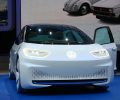
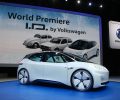
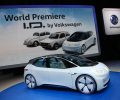
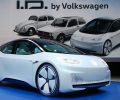
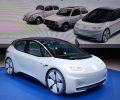
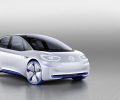
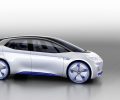
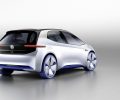
You must be logged in to post a comment.